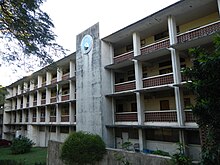astro.wikisort.org - Institution
The Manila Observatory is a non-profit research institute housed on the campus of the Ateneo de Manila University in Quezon City, Philippines. It was founded by the Society of Jesus, commonly known as the Jesuits, in 1865 as the Observatorio Meteorológico del Ateneo Municipal de Manila. It was later renamed Observatorio Meteorológico de Manila. It has done weather forecasting and earthquake research and today researches seismic and geomagnetic phenomena as well as radio and solar physics.
This article has multiple issues. Please help improve it or discuss these issues on the talk page. (Learn how and when to remove these template messages)
|
 | |
| Organization | Ateneo de Manila University |
|---|---|
| Location | Quezon City, Philippines |
| Coordinates | 14.63667°N 121.07667°E |
| Established | 1865 |
| Website | www |
 Location of Manila Observatory | |
| | |
History

An article published in Diario de Manila by Jesuit Fr. Jaime Nonell led to the observatory's establishment. The article described Jesuit Fr. Francisco Colina's observations of a typhoon in September 1865 and led the public[who?] to ask Jesuit superior Juan Vidal for the observations to be continued. After initial hesitation on the part of the Jesuits because of the primitive instruments available, the superior yielded upon the promise of a Secchi Universal Meteorograph purchased from the Holy See.[1] This started systemic observation of the Philippine weather.

The institute was founded and led by Jesuit cleric Federico Faura. It started issuing warnings on typhoons in 1879, and the next year earthquake observations. In 1884 the Spanish government recognized the observatory as the official institution for weather forecasting in the Philippines. It started its time service in 1885, seismology in 1887, and astronomy in 1899.[1]
The American colonial government established the observatory in 1901 as the Philippine Weather Bureau, which expanded into meteorology, astronomy, and geomagnetism.[1] The work of the bureau was interrupted by the Second World War. During the Battle of Manila, all of the instruments and important documents of the bureau were destroyed, and it ceased to function. A specific government agency was established in its place.[1] The observatory resumed operation in 1951 in Baguio, mainly for studies on seismology and the ionosphere. In 1963 it was transferred to the Loyola Heights campus of the Ateneo de Manila University where it continues its studies into seismology, geomagnetism, and radio physics, among other areas of research.[1]
Organizational structure

The observatory is mainly composed of two units: administration and research.[2] Administration is primarily composed of General Administration, Accounting, Human Resource, and Physical Facilities and Supplies. Research programs include Climate Change Assistance, Geomatics for Environment and Development, Instrumentation and Technology, Regional Climate Systems, Solid Earth Dynamics, Air Quality Dynamics, and Special Research Projects.[2] The observatory's recent special research projects are: Climate Change Adaptation – Disaster Risk Management and Co-benefits of Climate Change Mitigation.[2]
See also
- List of Jesuit sites
References
- "History". Manila Observatory. Archived from the original on 2018-09-03. Retrieved 2008-05-20.
- "Staff". Manila Observatory. Archived from the original on 2015-05-09. Retrieved 2015-10-20.
Further reading
- Herbermann, Charles, ed. (1913). . Catholic Encyclopedia. New York: Robert Appleton Company.
External links
На других языках
- [en] Manila Observatory
[ru] Манильская обсерватория
Манильская обсерватория - астрономическая обсерватория, основанная в 1865 году иезуитами в кампусе Манильского университета в Кесон-Сити, Филиппины. Основой задачей обсерватории в 19 веке было предсказание тайфунов.Другой контент может иметь иную лицензию. Перед использованием материалов сайта WikiSort.org внимательно изучите правила лицензирования конкретных элементов наполнения сайта.
WikiSort.org - проект по пересортировке и дополнению контента Википедии